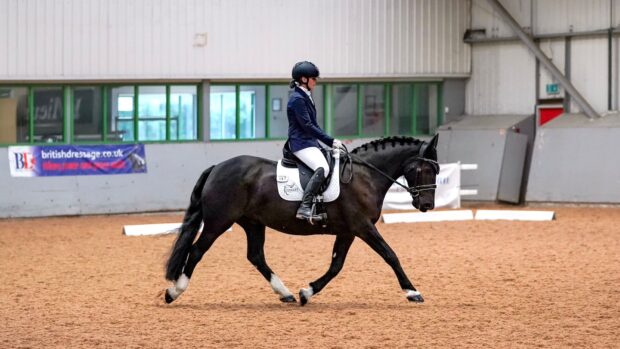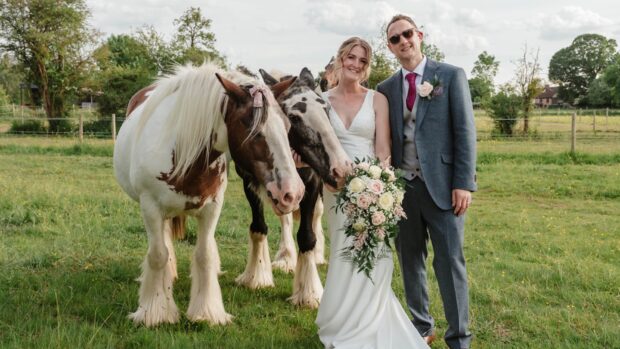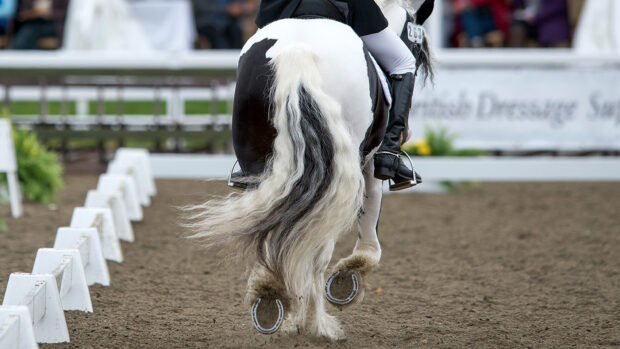If you want to buy a cob to compete in lightweight, heavyweight or maxi cob divisions, then this essential guide is a good place to start.
What is a show cob?
Cobs are a type of horse and their classes are some of the most popular and hotly-contested classes within showing. Under British Show Horse Association (BSHA) rules, show cobs are split into three categories; lightweight, heavyweight and maxi. Mares and geldings aged four years old and over are eligible to compete. At some shows, the weights are judged together, and some fixtures hold classes for novice cobs and amateur-owned cobs.
According to the BSHA rule book: “The cob is a type rather than a breed. A short-legged animal, with bone, substance and quality, capable of carrying a substantial weight. The cob should be well mannered and ideal for nervous or elderly riders. Cobs should have sensible heads, (sometimes Roman nosed), a full generous eye, shapely neck, well muscled, with a hogged mane (showing no significant growth) and well defined wither. The cob should also have clean, strong hocks and all the attributes of a good hunter; low movement and a comfortable ride.”
A lightweight should not exceed 155cm and have at least eight-and-a-half inches of bone. A heavyweight should also not exceed 155cm and have at least nine-and-a-half inches of bone. A maxi cob is more than 155cm but must be of true cob type. There is a recommended height limit of 160cm and judges must pay particular attention to type, judging them as they would a lightweight or a heavyweight cob.
Some show cobs can also compete in working show horse classes if they can jump. Cobs that are skewbald, piebald or another variation can compete in coloured classes, and many horses are successful under both guises during their careers.
Showing is not the only sphere cobs excel in, though, and they are also popular choices for riders of all levels, abilities and ambitions. Cobs are often seen in lower-level dressage competitions, and in the riding club. They also make good all-rounders or hackers, usually due to their heavier stamps and sometimes quieter dispositions.
What to look for in a good show cob
Reid Finlay has been responsible for finding many top-class show animals before they went onto become famed rides in the ring. Cobs he has discovered have won titles at major shows such as the Royal International (RIHS), Horse of the Year Show (HOYS), Royal Windsor and other national and county shows. He has discovered multiple former H&H cover stars, too, including champion show cobs Copenhagen, Colour Index, Lord Alexander, Colebrooke and Colebourne, as well as the traditional cob The Magpie.
“The priority should always be the frame of the animal,” says Reid. “Prospective buyers should not be considering condition of a potential show cob, but the frame that is there to furnish. I also look for clean limbs, plenty of quality bone — enough to do the right job — and nice flat knees. Good-sized, open feet are also essential.
“The step is also very important; if a cob doesn’t move you’ll be swimming uphill from day one.”
Reid says that there are a couple of no-nos that he would advise buyers to look out for when they are looking to buy a show cob: “I would avoid a horse that dishes, and a lot of cobs have no pasterns; the foot often comes straight out of the fetlock. Any show animal also needs to possess manners as it’s so important for their job; if a horse doesn’t stand in the ring, for example, it could easily cost it their placing.”
When it comes to maxi cobs, Reid says that we should be looking for the same quality, type and conformation as we would in a lightweight and heavyweight cob.
“There is no maximum height but I prefer them not to exceed 16.1hh, and I like to find maxis that will finish off at about 15.3hh or 16hh,” he says. “A good test of type is if you stand a cob against a blank background, you should not be able to tell that it’s a maxi, it should just look like a cob. Basically, we don’t want tall horses with their manes taken off, the type still needs to be there.”
Where should I buy a cob from?
Show cobs for sale will be advertised at various times in the season on online platforms, as well as via horse dealers, private sellers and via word of mouth.
“When you buy from depends on your level of experience,” says Reid. “If you aspire to go straight into the county level circuit but it’s all new to you, then you are best to take advice from someone who has been there and done it.”
How much should I expect to pay?
The cost of a show cob depends on various factors, including the age and competition record of the horse, or the potential of it if it is a younger model.
Cobs are one of the most in demand types of horses because of their versatility and suitability to different riders. This is reflected in the market for cobs, which is competitive. Prices for quality cobs with show ring records or with potential are usual at the higher end. While you can expect to pay slightly less for a low-level cob of lesser quality, there is still a strong want for such horses if they are safe, sane and sensible.
What happens when I’ve agreed to buy a show cob?
When you have found the right horse for you, then it’s time to arrange a pre-purchase vetting, something that is strongly recommended.
The vet will assess the horse with the specific job you want it for in mind, so it’s important to let the vet know prior to the vetting that your main goal is to compete in the show ring as a cob. As you want the horse for showing, the vet should pay close attention to any conformational faults which could impact its future career, even if they don’t impact soundness or performance. Show horses should be clean limbed and have no blemishes, either.
“Every horse that leaves my yard goes with a clean five-stage vetting certificate,” says Reid. “Vettings are essential for both buyer and seller, as everyone knows where they stand from day one.”
You may also be interested to read…
How should you present a show cob correctly and how are the different weight categories defined?

H&H’s guide to show cob classes: from weight divisions to showing off correctly

Subscribe to Horse & Hound magazine today – and enjoy unlimited website access all year round




